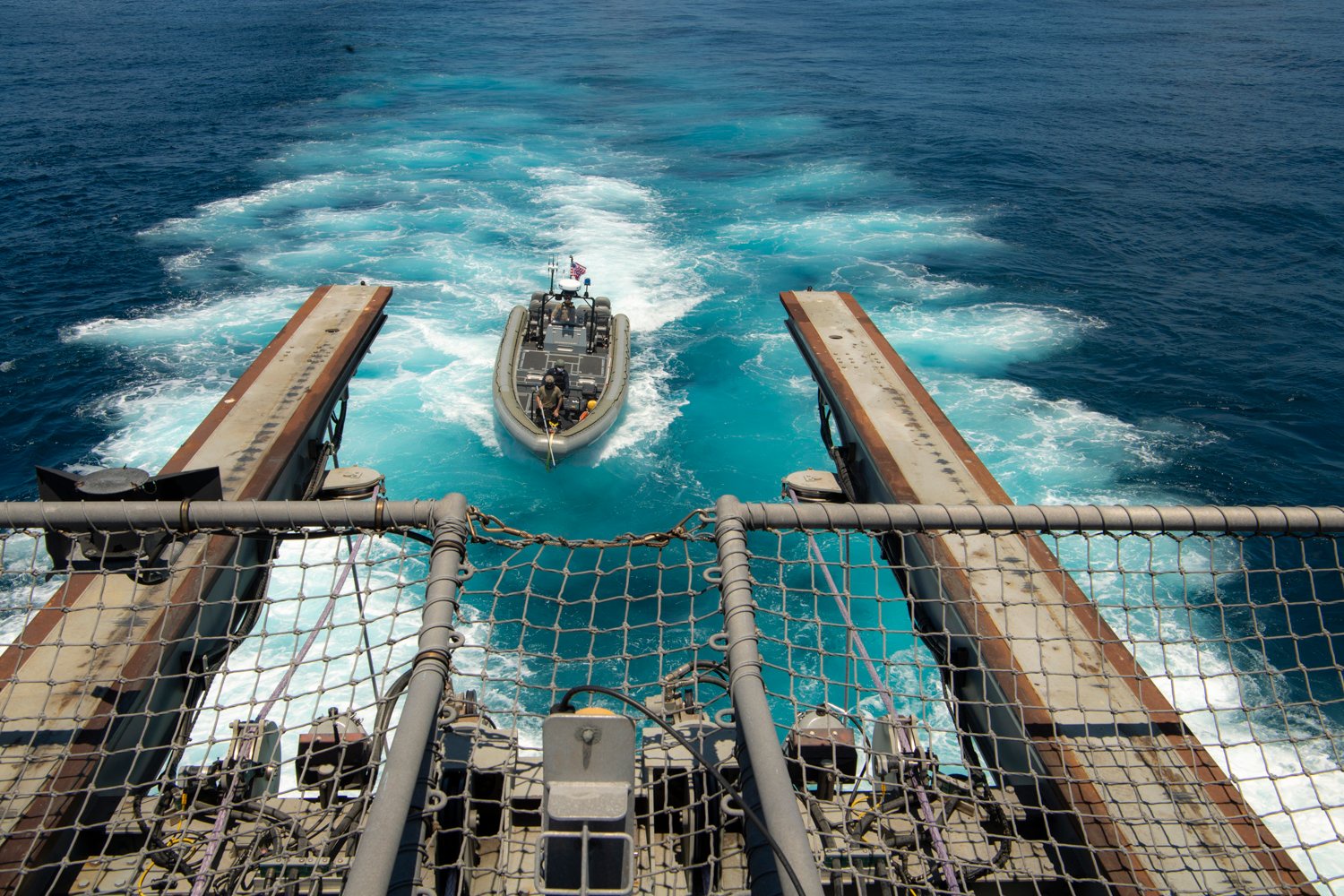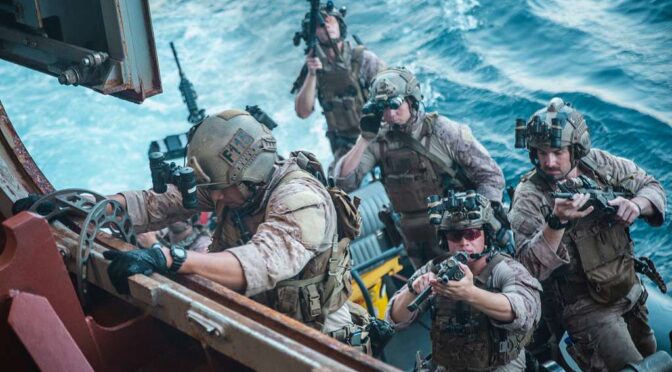By Clay Robinson
U.S. Central Command poses an opportunity for the Marine Corps. During his March 2023 testimony to the House Armed Services Committee (HASC), CENTCOM commander General Erik Kurilla stated, “God forbid there’s ever a conflict with China, but we could end up holding a lot of their economy at risk in the CENTCOM region.”1 In the same testimony he pointed to how “72 percent of all Chinese oil is imported. That can make them vulnerable.”2 Then General Kurilla zeroed in on the sea lanes within the Middle East adding, “98 percent-plus goes through by ship. That makes them vulnerable.”3
The Marine Littoral Regiment (MLR) could be the contact and blunt force that is tasked with the mission of holding key Chinese imports at risk in the Middle East. Force Design should be modified to embrace this mission by adding Maritime Interception Operations (MIO) to the core mission sets of MLRs. The MIO mission is currently assigned only to Marine Expeditionary Units, but the MLR’s low signature, platoon-sized maneuver elements with organic operational mobility, combined with a “mothership” such as an Expeditionary Mobile Base (ESB) and Littoral Combat Ships (LCS), could make the MLR ideally suited for large-scale MIO.4
Force Design has received varying levels of critique, such as that from former Senator and Secretary of the Navy Jim Webb for charting a course that could “eliminate many of the Marine Corps’ key capabilities and permanently reduce the long-standing mission of global readiness.”5 Another criticism levied the concern that “A force tailored to fight in a specific region of the world may find itself unable to operate effectively in a markedly different climate. The Marine Corps cannot afford to have a significant portion of its fighting units dedicated to only operating in a specific area of the world — in this case, the Indo-Pacific region.”6 Adding the MIO mission to MLRs could represent common ground. By expanding the mission of the MLRs to provide greater utility outside the Indo-Pacific region, the Marine Corps can still address great power threats while enhancing global readiness.
During a PRC invasion of Taiwan, U.S. INDOPACOM could unleash a “Hellscape” of thousands of unmanned platforms to swarm the Taiwan Strait and keep China’s military off balance until more assets arrive.7 Meanwhile in the Middle East, a more nuanced mission of MIO requiring skills akin to those proposed by Major General Dale Alford, USMC, (ret.) in his 2021 article titled, “The Four-Block Littoral Force,” could fall to the Marine Corps. Marines could be called upon to rapidly help CENTCOM impose economic costs on China by boarding high-value ships, plucking them from nearby maritime chokepoints like the Strait of Hormuz, the Red Sea approaches to the Suez Canal, and the Bab-el-Mandeb Strait.

This force would form the nucleus of the prize crews that will keep the ships from reaching Chinese ports. MLR Marines would maintain control and security of the prize vessel and could be augmented by seasoned mariners with expertise in seamanship, navigation, and engineering. This additional seafaring expertise might come from members of the U.S. Coast Guard or a modern version of the U.S. Maritime Service (USMS) such as that proposed by Wade Heath who recently suggested that the USMS be codified as a full-fledged uniformed service, on par with the U.S. Public Health Service or National Oceanic and Atmospheric Administration.8
In his reimagination of General Charles Krulak’s Three Block War, General Alford describes the “Four-Block Littoral Force” as emphasizing “operations in the littorals, especially maritime chokepoints.”9 General Alford’s Block 1 requires a littoral-focused gray-zone contact force with Marines operating persistently in maritime chokepoints, prepared to support the fleet.10 After Block 2 (the crisis response force), his Block 3 requires a blunting force of platoon, company, and battalion-level units that “could come from one, two, or perhaps even all of the following: a permanent base, an expeditionary advanced base, an amphibious ship, or perhaps even from non-standard, improvised commercial vessels.”11 General Alford concludes with a Block 4 (destroying force).
The contact (1) and blunting (3) blocks align well with the use of MLR Marines as a cadre of highly-trained boarding parties that feature an appropriate balance of quality and quantity for the mission. The combination of both quality and quantity is where the Marine Corps excels, making Marines better suited for a large-scale MIO mission over boarding parties formed by surface fleet sailors or special operators. The former lack both proficiency in seizing territory and the ability to use a variety of boarding team delivery platforms, to include helicopter insertion. The latter lacks the numbers that would be required to strangle an impactful portion of the Chinese maritime economy. There have simply never been enough resources to sufficiently train shipboard VBSS teams to excel using a variety of insertion techniques for what has almost always been a collateral duty mission for surface sailors. Meanwhile, SEAL Teams can truly excel at small numbers of these boardings, but there are just not enough of them to address the numbers of vessels required of this campaign. MLRs are also better suited for folding seized vessels into the broader littoral terrain and operations that MLRs focus on.

A MLR operating from an amphibious warfare ship or expeditionary mobile base (ESB) and conducting distributed operations across several LCSs might be capable of fielding upwards of 20 Visit, Board, Search, and Seizure (VBSS) teams. CENTCOM already operates the forward-deployed ESB, USS Lewis B. Puller, and plans are well underway to forward deploy four Littoral Combat Ships (LCS) to Bahrain beginning in 2025.12 Although ostensibly planned to replace mine warfare vessels, these LCSs can be expected to ply the same constrained, littoral waters the MLRs could use and perhaps some efficiencies could result. The MLR could also benefit from aspects of Expeditionary Advance Base Operations and naval integration such as operating from foreign vessels, non-standard vessels, and vessels of opportunity that are routinely being tested and experimented upon, like the embarkation of Marines on LCS-class ships.13,14 Beyond the boarding mission, MLR Marines would be useful for the close-contact, gray zone encounters that frequently occur in steady state operations across theaters.
Conclusion
In his June 2023 update on Force Design, General Berger reported that “The Navy and Marine Corps will continue to prioritize our sea-based expeditionary forces to maximize their forward presence as a keystone of our contribution to integrated deterrence. To deter or respond, we must be postured forward, operating from the sea.”15 Employing MLRs in maritime interception operations that can rapidly seize merchant vessels, form the nucleus of subsequent prize crews, and inflict pressure on great power rivals across multiple theaters can contribute significantly to deterrence. MLR Marines could be the professional teeth that hold Chinese maritime commerce at risk in the Middle East and elsewhere. As defense leaders look for creative yet feasible options to deter China from a 2027 invasion of Taiwan, the vulnerability of critical Chinese energy imports to maritime interdiction by agile MLR Marines could be part of the solution. It is time for Force Design to make the MIO mission a core contribution of the Marine Littoral Regiment.
Commander Clay Robinson is a retired U.S. Navy surface warfare officer with over twenty-
five years of experience in naval operations and strategic planning. He is currently an
adjunct instructor with the U.S. Naval Community College.
References
[1] Hunt, Edward. “In the Middle East, the U.S. Holds China at Risk,” Foreign Policy in Focus, May 16, 2023, https://fpif.org/in-the-middle-east-u-s-holds-china-at-risk/
[2] Hunt, Edward. 2023.
[3] Hunt, Edward. 2023.
[4] Headquarters Marine Corps. “Marine Littoral Regiment,” The Official U.S. Marine Corps Public Website, January 11, 2023, https://www.marines.mil/News/News-Display/Article/2708146/marine-littoral-regiment-mlr/
[5] Webb, James. “The Future of the U.S. Marine Corps,” The National Interest, May 8, 2020, https://nationalinterest.org/feature/future-us-marine-corps-152606?page=0%2C2
[6] Wilson, Gary, Woods, William, and Wyly, Michael. “Send in the Marines? Reconsider Force 2030 beforehand,” Defense News, August 4, 2022, https://www.defensenews.com/opinion/commentary/2022/08/04/send-in-the-marines-reconsider-force-design-2030-beforehand/
[7] Rogin, Josh. “The U.S. military plans a ‘Hellscape’ to deter China from attacking Taiwan,” The Washington Post, June 10, 2024, https://www.washingtonpost.com/opinions/2024/06/10/taiwan-china-hellscape-military-plan/
[8] Heath, Wade, “Reestablish the U.S. Maritime Service,” U.S. Naval Institute Proceedings, October 2024, https://www.usni.org/magazines/proceedings/2024/october/reestablish-us-maritime-service
[9] Alford, Dale, “The Four-Block Littoral Force: The Infantry’s attack toward Force Design 2030,” Marine Corps Gazette, June 2021, https://buff.ly/3jjNZpD
[10] Alford, Dale. 2021.
[11] Alford, Dale. 2021.
[12] Renfroe, Shannon. “LCS Quartet being lined up by Navy for Middle East Mine Operations,” Stars and Stripes, May 17, 2024, https://www.stripes.com/branches/navy/2024-05-17/lcs-mine-countermeasure-ops-13875628.html
[13] Shelbourne, Mallory. “Moving Marines Across the Pacific Could Be Littoral Combat Ship’s Next Mission,” U.S. Naval Institute News, September 28, 2021, https://news.usni.org/2021/09/28/moving-marines-across-the-pacific-could-be-littoral-combat-ships-next-mission
[14] Reiher, Dan and Cuomo, Scott. “The LCS Advantage for the Navy-Marine Corps Team,” U.S. Naval Institute Proceedings, November 2022, https://www.usni.org/magazines/proceedings/2022/november/lcs-advantage-navy-marine-corps-team
[15] Headquarters Marine Corps. “Force Design 2030,” March 2020, https://www.hqmc.marines.mil/Portals/142/Docs/CMC38%20Force%20Design%202030%20Report%20Phase%20I%20and%20II.pdf
Featured Image: Arabian Gulf (July 26, 2019) Marines with the Maritime Raid Force, 11th Marine Expeditionary Unit (MEU) climb a tactical assault ladder to board the amphibious transport dock ship USS John P. Murtha (LPD 26) during a visit, board, search and seizure training exercise. (U.S. Marine Corps photo by Cpl. Matthew Teutsch/Released)


Keep the LCS for other purposes. Lease another offshore supply vessel and turn it into a tender for a squadron of fast supply vessels. Stick davits or stern launch on those FSVs and sortie with the Marines/VBSS/SEALS etc. Make sure that OSV has a helo deck. You could do this on the cheap and do it several times before burning the cash just to move one LCS into this role. If you dig around the internet there are some reports back in the early 2000s talking about this.